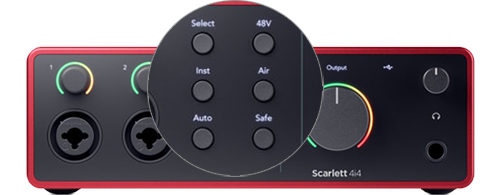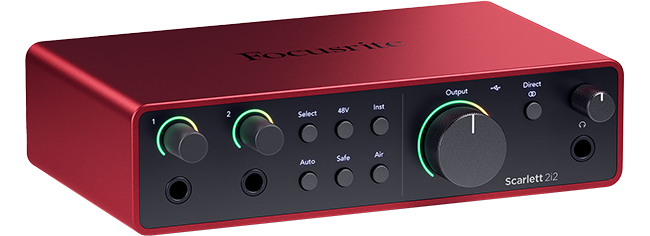The new Focusrite 4th Gen Scarlett
After the 2011 launch of their now seminal Scarlett line of interfaces, Focusrite, not content with having one of their instantly recognisable crimson interfaces in the home of every hobbyist producer, have also consistently strived to add more professional level features to these very same entry level interfaces. 3rd Gen was hailed as a giant leap forward in the simplification of the front panel design and the improvement in mic pre-amps, line level inputs and bus power via USB-C. With an eight-year gap between launch and 3rd Gen, technology had moved on enough to warrant an overhaul.
With only half that time given to the 4rd Gen launch you would be forgiven for believing Focusrite’s 4th Gen improvements might be superfluous, however, 4th Gen heralds another big step towards professional level audio interfaces without having to completely overhaul the much-loved design or bump the price in the wrong direction.
The Design
Focusrite have a large vibrant community that provide constant feedback regarding their interfaces, and Focsurite listens - looking to tweak, improve or make the look and usability of the interface more efficient. On the 4th Gen Scarlett 2i2, gone are the front facing combi inputs separated for front facing ¼-inch line inputs and rear facing XLR inputs. The same four ¼-inch outputs from the 3rd Gen Scarlett are also found on the new 4th Gen Scarlett 4i4 models with an additional two ¼-inch inputs.

The 4i4 still retains front facing combi inputs but the separate air/instrument settings are now simplified into one section across all three models, with some exciting additions and improvements.
4th Gen Scarlett 2i2 (two rear facing XLR inputs)

3rd Gen Scarlett 2i2

While both 3rd and 4th Gen interfaces record 24bit audio up to 192hz the 4th Gen interfaces all feature Focusrite’s RedNet converters, until now only available in their top of the range professional interfaces. This means the three entry level interfaces now have considerably improved AD/DA conversion committing a cleaner signal with less chance of uninvited noise at high gain.
Pre-Amp/Gain Range
Another big improvement is in the trio’s pre-amp/gain range, 4th Gen boosts 3rd Gen gain range to around 69db for XLR making them more compatible with mics such as the SM7B which previously would have needed inline mic pre-amps. There is also a boost for line level inputs helping quieter devices.
Air mode was introduced with 3rd Gen to help boost the presence of line level inputs to cut through the mix. Air mode still exists on 4th Gen interfaces giving a slight clean lift to your line level instrument. Additionally, there is an Air + Drive setting pumping the mid-range adding a fatness to line level inputs and vocals.
Auto Gain & Clip Safe Mode
Two completely new features for 4th Gen Scarlett interfaces are Auto Gain and Clip Safe mode. Auto Gain will take a check of your signal and will look to set the perfect gain level for that input. This feature is great for consistent line level inputs but for those less consistent inputs such as vocals or guitar solos, Focusrite have implemented Clip Safe mode - automatically reducing the gain so you don’t clip or distort your recording. This level of detail for entry level interfaces is a game changer in the market and should help novice producers avoid those early mistakes with distorted takes.
Loopback
Another game changer is the addition of loopback, the ability to send computer audio back to the DAW via virtual inputs - allowing you to mix and balance computer audio with your mic/line inputs and make streaming and podcasting so much easier. For those of us who have tried to stream DAWs in the past, we know how difficult it can be with complex virtual channels using 3rd party plugins. Loopback is going to give you complete control over all your audio. Great for gamers, streamers, podcasters and musicians alike.
Optional External Power
The 4th Gen Scarlett 2i2 and 4i4 both feature a second USB-C power input. This dedicated power source allows you to connect to more powerful portable devices, or simply ease the power burden from you your home PC or Laptop.

Conclusion
The Focusrite 4th Gen Scarlett interfaces, like the 3rd Gen, are built to last, featuring highly regarded quality components such as Neutrik inputs. The layout of the 4th Gen Scarlett sees an intelligent use of space, meaning even those of us with the chubbiest of fingers can still access all the knobs and buttons without inadvertently turning off or adjusting any vital settings. Some will lament the lack of front facing XLR access, but for cable management it will make keeping those 10 metre XLR cables out of sight so much easier.
Focusrite 4th Gen Scarlett interfaces take the already incredible 3rd Gen Scarlett a few steps further - allowing higher quality headphones direct into the interface, gain hungry microphones no longer needing in-line pre-amps, and the addition of Air + drive will give added punch to those all-important mids crucial for vocals and guitar. Most importantly, the addition of loopback opens up the Focusrite Scarlett interface market to streamers, gamers and podcasters, solidifying Focusrite’s incredible appeal to a new and alternate generation of audiophiles.